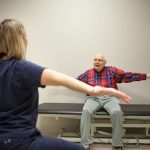What Is A Home Safety Evaluation?
Sage Outpatient’s interdisciplinary therapy team consisting of physical, occupational, speech therapists, and a social worker routinely participate in home safety evaluations. Specifically, individuals who have sustained a fall, a new diagnosis of stroke, Parkinson’s disease, or spinal cord injury will likely benefit from a home safety evaluation. A home safety evaluations is performed by a skilled clinician to assess the home environment of our patients with the goal being maximum patient safety and independence. Therapists determine potential safety hazards, modifications to increase patient independence within household walking and daily living tasks, implement communication or memory cues, and/or recommendations of future needs for individuals with progressive illnesses.
Benefits of a home safety evaluation include:
- Fall prevention
- Home modifications
- Incorporating needs into treatment sessions
Fall Prevention
1 in 4 older adults fall each year, most of which could be prevented.1
A physical and occupational therapist’s role is to not only to address environmental safety concerns within your home that increase your risk of falls, but also to make recommendations for safe alternatives to alleviate these risks.
Possible fall hazards may include:
- Throw rugs
- Dim lighting
- Doorway thresholds
- Confined walking paths
Home Modifications
For most individuals, small and relatively inexpensive changes to their home environment can drastically increase their independence and safety while performing daily tasks. Therapists have extensive knowledge in available resources and expected barriers. Individualized recommendations can be provided that will support further recovery.
Common complaints which can be addressed may include:
- Difficulty getting out of bed
- Concerns with stepping in and out of the shower
- Inability to safely transfer to the toilet
- Falling when walking around in the home
- Increased reliance on caregivers while eating or styling hair
- Inability to remember the sequence of a daily routine
Possible home modifications to improve accessibility may include:
- Adaptive feeding and grooming tools
- Rails and grab bars
- Wheelchair ramps
- Shower benches
- Rearranging current set-up
- Adding reminder signs
Incorporating Assessment in Treatment Sessions
In conclusion, home safety evaluations will give your therapy team a better understanding of how to maximize your potential during treatment sessions to achieve your personal goals. Therapists can integrate activities that are important to you in order to increase engagement and functional progress.
Above all, home safety evaluations are a beneficial process performed by skilled therapists to ensure patient safety and independence within the home. Sage Outpatient and Day Neuro clinicians can provide recommendations by incorporating knowledge with individual patient needs. Following the evaluation, the therapist will also provide detailed suggestions and resources to assist with these transitions.
References:
- Important Facts about Falls. Centers for Disease Control and Prevention. Published February 10, 2017.
For more information, contact us at 225-906-4097.





